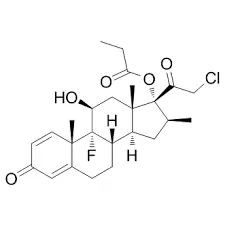Clobetasol powder is a strong topical corticosteroid utilized to treat different skin conditions, counting skin inflammation, psoriasis, and dermatitis. Appropriate application of this pharmaceutical is significant for its adequacy and to minimize potential side impacts. This web journal post will direct you through the redress application handle of Clobetasol powder to guarantee you get the most advantage from your treatment.

What is the proper way to prepare the skin before applying Clobetasol powder?
Before applying Clobetasol powder, it's essential to properly prepare your skin to maximize the medication's effectiveness and minimize potential irritation. Here are the steps to follow:
- Clean the affected area: Gently wash the area where you'll be applying the Clobetasol powder with mild, unscented soap and lukewarm water. This step helps remove any dirt, oils, or debris that could interfere with the medication's absorption.
- Pat dry: After washing, use a clean, soft towel to gently pat the area dry. Avoid rubbing, as this can irritate sensitive skin.
- Allow the skin to cool: If you've just bathed or showered, wait for about 10-15 minutes to allow your skin to cool down and return to its normal temperature. Applying medication to warm, damp skin can increase absorption, potentially leading to more side effects.
- Check for open wounds or infections: Inspect the area for any cuts, scrapes, or signs of infection. Clobetasol powder should not be applied to open wounds or infected areas unless specifically directed by your healthcare provider.
- Remove any residual creams or ointments: If you've been using other topical treatments, make sure they've been completely absorbed or gently wipe them off before applying Clobetasol powder.
- Protect surrounding skin: If the affected area is small or localized, you may want to apply a thin layer of petroleum jelly to the surrounding healthy skin. This can help prevent the Clobetasol powder from spreading to unaffected areas.
By following these preparation steps, you create an ideal environment for the Clobetasol powder to work effectively. Remember, proper skin preparation is just as important as the application itself in ensuring the best possible treatment outcomes.
How often should Clobetasol powder be applied to the skin?
The frequency of Clobetasol powder application depends on several factors, including the severity of your condition, the specific area being treated, and your healthcare provider's instructions. Here's a general guide to help you understand the typical application frequency:
- Initial treatment: In most cases, Clobetasol powder is applied once or twice daily during the initial treatment phase. This phase usually lasts for about two weeks.
- Maintenance treatment: After the initial phase, your healthcare provider may recommend reducing the frequency to once daily or even less, depending on your response to the treatment.
- Short-term use: Clobetasol is a high-potency corticosteroid and is generally not recommended for long-term continuous use. Most treatment courses last between two to four weeks.
- Intermittent use: For chronic conditions, your doctor may prescribe intermittent use, where you apply the powder for a few days or weeks, followed by a break before resuming treatment.
It's crucial to follow your healthcare provider's instructions precisely. Here are some additional considerations regarding the frequency of application:
- Consistency is key: Try to apply the Clobetasol powder at the same time(s) each day to maintain a consistent level of medication on your skin.
- Don't increase frequency: Applying the powder more often than prescribed won't lead to faster healing and may increase the risk of side effects.
- Missed doses: If you forget a dose, apply it as soon as you remember. However, if it's almost time for your next scheduled application, skip the missed dose and continue with your regular schedule.
- Gradual reduction: When stopping treatment, your healthcare provider may recommend gradually reducing the frequency of application to prevent withdrawal symptoms or rebound effects.
- Monitoring: Keep track of how long you've been using the Clobetasol powder and report any changes in your condition to your healthcare provider.
Remember, the goal of treatment with Clobetasol powder is to control your symptoms with the lowest possible dose for the shortest duration necessary. Your healthcare provider will work with you to find the right balance between effective treatment and minimizing potential side effects.
Can Clobetasol powder be used on all areas of the skin?
Whereas Clobetasol powder is a effective and successful treatment for different skin conditions, it's not reasonable for utilize on all ranges of the skin. Understanding where and how to utilize this medicine is pivotal for secure and compelling treatment. Here's a comprehensive direct on the suitable utilize of Clobetasol powder on distinctive zones of the skin:
Areas where Clobetasol powder can be used:
- Scalp: Clobetasol powder is often prescribed for scalp psoriasis or severe dandruff. When applying to the scalp, part the hair to ensure the powder reaches the skin directly.
- Trunk: The powder can be used on the chest, back, and abdomen for conditions like psoriasis or eczema.
- Arms and legs: Clobetasol powder is suitable for use on the arms and legs, including elbows and knees, which are common areas affected by psoriasis.
- Hands and feet: The powder can be applied to the palms and soles for conditions like palmoplantar psoriasis or eczema.
Areas to use with caution:
- Face: Clobetasol powder should be used on the face only if specifically prescribed by your healthcare provider. The skin on the face is thinner and more sensitive, making it more prone to side effects.
- Skin folds: Areas like the groin, armpits, and under the breasts should be treated with caution. These areas have thinner skin and increased absorption, which can lead to more side effects.
- Genital area: Use in the genital area should only be done under strict medical supervision due to the sensitivity of the skin in this region.
Areas to avoid:
- Eyes and eyelids: Never apply Clobetasol powder near the eyes or on the eyelids, as it can cause glaucoma or cataracts if it enters the eyes.
- Open wounds or infections: Avoid applying the powder to any areas with open sores, cuts, or active infections.
- Mouth and lips: Do not use Clobetasol powder inside the mouth or on the lips.
When using Clobetasol powder, always follow these guidelines:
- Utilize as it were as coordinated: Apply the powder as it were to the regions indicated by your healthcare provider.
- Avoid impediment: Unless coordinated by your specialist, maintain a strategic distance from covering the treated ranges with tight clothing or gauzes, as this can increment assimilation and the chance of side effects.
- Monitor for side impacts: Be mindful of any changes in your skin, such as diminishing, discoloration, or the improvement of extend marks, particularly in touchy areas.
- Limit treatment length: Utilize Clobetasol powder for the most limited time conceivable to accomplish the craved impact, ordinarily no more than two to four weeks.
- Gradual suspension: When ceasing treatment, particularly after drawn out utilize, your healthcare supplier may prescribe steadily diminishing the recurrence of application to avoid withdrawal impacts.
Conclusion
Remember, while Clobetasol powder is a powerful tool in treating various skin conditions, it's essential to use it responsibly and under medical supervision. Always consult your healthcare provider if you have any questions or concerns about using Clobetasol powder on specific areas of your skin.
If you are also interested in this product and want to know more product details, or want to know about other related products, please feel free to contact lea_slsbio@163.com,WhatsApp+86 13193326505.

References
1. National Institutes of Health. (2023). Clobetasol Topical. MedlinePlus.
2. American Academy of Dermatology Association. (2021). Topical Corticosteroids.
3. British Association of Dermatologists. (2022). Topical Corticosteroids. Patient Information Leaflets.
4. DermNet NZ. (2023). Topical Steroids.
5. Mayo Clinic. (2022). Clobetasol (Topical Application Route).
6. UpToDate. (2023). Clobetasol: Drug information.

